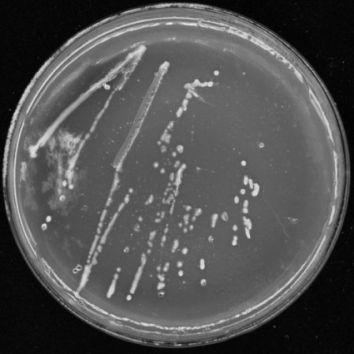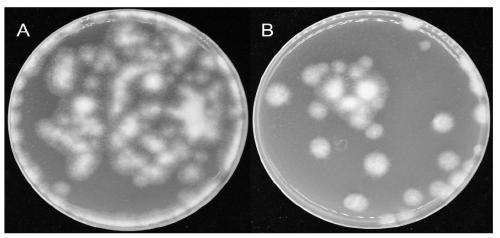Paenibacillus polymyxa strain and application thereof
A technology of Paenibacillus polymyxa and bacterial strains, which is applied in the field of microorganisms, can solve the problems such as the lack of biocontrol strains of Paenibacillus polymyxa, and achieve the effects of wide development and application prospects, strong stability, and strong antibacterial effect
- Summary
- Abstract
- Description
- Claims
- Application Information
AI Technical Summary
Problems solved by technology
Method used
Image
Examples
Embodiment 1
[0031] Example 1 Isolation and identification of Bacillus polymyxa strain YT9
[0032] Soil sample collection: Soybean rhizosphere soil at a depth of 5-10cm was collected from different soybean plots in Yantai City, Shandong Province, brought back to the laboratory, and separated by flat plate dilution coating method.
[0033] Strain isolation medium: The medium is beef extract peptone agar (NA) medium: beef extract 3g, peptone 10g, NaCl 5g, sucrose 15g, agar 20g, add distilled water to dilute to 1000mL, pH7.2-7.4, 121℃ Sterilize for 20 minutes.
[0034] Separation by plate dilution coating method: Mix the collected soil sample thoroughly, weigh 10g, put it into a triangular flask with a proper amount of glass beads and 90mL sterile water, place the triangular flask on a shaker, shake for 20min, and statically Leave it for 5 minutes, and dilute in sequence with a 10-fold gradient dilution method. Take 10 -4 , 10 -5 , 10 -6 200μL each of the soil diluent, evenly spread on the NA pla...
Embodiment 2
[0036] Example 2 Inhibition of Bacillus polymyxa YT9 on different pathogens
[0037] In the center of the V8 solid medium plate, a 6mm diameter of Phytophthora sojae, Phytophthora capsici, Phytophthora tabaci, Rhizoctonia solani, Rhizoctonia solani, Phytophthora sojae, Phytophthora capsici, Rhizoctonia solani, Phytophthora sojae, Phytophthora capsici, Rhizoctonia sp 2.5cm on one side of the bacterial cake was inoculated with the Bacillus polymyxa strain YT9 of the present invention, and a blank control was added to the other side. Each test strain was repeated 5 times and cultured in the dark in a 25°C incubator. According to the growth rate of the pathogenic bacteria 4-8 days later, observe and measure the width of the bacteriostatic zone and determine the bacteriostatic rate. The specific results are shown in Table 1.
[0038] Bacteriostatic rate = (control side colony radius-opposite side colony radius) / control test colony radius * 100%.
[0039] Table 1. Inhibition rate of strai...
Embodiment 3
[0043] Example 3 The effect of aseptic fermentation filtrate of Bacillus polymyxa strain YT9 on the zoospore activity of Phytophthora sojae
[0044] After the strain YT9 was activated, it was inoculated into a 250 mL Erlenmeyer flask containing 50 mL of fermentation medium. The fermentation stock solution was cultured on a shaker at 30°C at 180 rpm for 2 days. After centrifugation at 12000 rpm for 5 minutes, it was filtered with a 0.22 μm bacterial filter. , Obtain aseptic fermentation filtrate. The freshly activated Phytophthora sojae strain was cultured in 10% V8 liquid for two days and then the water was changed to induce a large number of zoospores (10 4 / ML). One group took 450 μl zoospores + 450 μl sterile filtrate + 100 μl V8 (treatment group); the other group took 450 μl zoospores + 450 μl fermentation medium + 100 μl V8 (control group), placed at 25°C for 3 hours and then performed microscopic observation. And each 200μl of the mixed solution was spread on the V8 plate...
PUM
 Login to View More
Login to View More Abstract
Description
Claims
Application Information
 Login to View More
Login to View More - R&D
- Intellectual Property
- Life Sciences
- Materials
- Tech Scout
- Unparalleled Data Quality
- Higher Quality Content
- 60% Fewer Hallucinations
Browse by: Latest US Patents, China's latest patents, Technical Efficacy Thesaurus, Application Domain, Technology Topic, Popular Technical Reports.
© 2025 PatSnap. All rights reserved.Legal|Privacy policy|Modern Slavery Act Transparency Statement|Sitemap|About US| Contact US: help@patsnap.com



